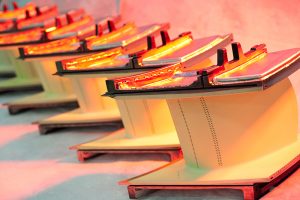Materials Science and Engineering has provided the chapter titles in the book of human history: the Stone Age, the Bronze Age, and the Iron Age. Although all fields of science and engineering are important, it is the advancements in materials science that have marked critical eras of human advancement. I have often wondered whether, hundreds or thousands of years from now, historians would say we are currently in the Silicon Age due to the transformational emergence of the silicon transistor chip. But in recent years, I’ve come to the conclusion that the history books will label this the “Additive Age”.
About six decades ago, Materials Scientists discovered that under very controlled conditions, machines could control the crystallographic orientation of materials as they cooled from a liquid to a solid. One layer at a time, Materials Scientists created “single crystals” which could build off one another “growing” into the desired object. This allowed scientists and engineers to make single crystal wafers with atomically uniform electrical properties and it was this same process which went on to enable the modern silicon transistor chip.
And with that Additive Technology was born.

The latest Thermal Barrier Coatings (TBCs) are applied layer by layer with a high velocity high temperature Plasma Spray process on the component surface.
And as additive manufacturing enabled the computer chip, the computer chip enabled greater computational power, which allowed Materials Engineers to extend additive manufacturing not only to lithographic printing of ever smaller p-n junctions on single crystal silicon, but also to many other applications.
So what does this mean for manufacturing?
The opportunities to use Additive Manufacturing for both large and small scale projects are endless. At Mitsubishi Hitachi Power Systems Americas, we use additive technology in the development of the largest, most fuel efficient gas turbines in the world.
For example, we use the same single crystal technology that was developed for silicon chips to manufacture large turbine blades that are directionally solidified. This means we start with seed crystals and grow them all in one direction so that the boundaries between them are all oriented along the major stress axis of the blade. We have had great success using this process to maximize the service life of our turbine blades at ever higher temperatures.
In addition, we use additive manufacturing to deposit ceramic coatings on many of the cooled components in our turbine. Through a process called plasma spraying, we deposit these coatings one layer at a time, they then act as insulating “thermal barriers” between the very hot gasses that flow through our turbine and the alloys that our components are made from. These additive technologies are critical to improving fuel efficiency, which has enabled a dramatic reduction in carbon dioxide emissions in the latest generation of power plants versus the older coal-fired power plants they often replace.
More recently, Mitsubishi Heavy Industries Group has begun to use additive technology to “print” components for gas turbines. Today, we’re able to print these same components in three dimensions, by using lasers to solidify powders, one layer at a time, in a complex three dimensional pattern. Using 3D printing, we can rapidly prototype new designs that we want to test, and we can even print production-ready parts.
Outside of MHPS, other group companies within Mitsubishi Heavy Industries are also leveraging additive manufacturing techniques to speed up production and customize specific pieces of machinery. From the development of turbocharger prototypes to proposed usage in the aviation and medical industries, companies across the world continue to find more and more uses for additive technology.
So welcome to the Additive Age of human history.
 Paul Browning is President and CEO of Mitsubishi Hitachi Power Systems Americas (MHPS-AMER), Inc. and oversees all Western Hemisphere business activities. With over 2,000 employees and headquartered in Central Florida, MHPS-AMERA operates four manufacturing and repair centers and provides products/services for the electric power generation industry. Browning has extensive global leadership experience in distributed and central power generation, and in North American midstream and downstream oil and gas operations. Prior to joining MHPS-AMER, Mr. Browning was President and CEO for Irving Oil Company Limited and was President and CEO of the Thermal Products Division of GE Power & Water.
Paul Browning is President and CEO of Mitsubishi Hitachi Power Systems Americas (MHPS-AMER), Inc. and oversees all Western Hemisphere business activities. With over 2,000 employees and headquartered in Central Florida, MHPS-AMERA operates four manufacturing and repair centers and provides products/services for the electric power generation industry. Browning has extensive global leadership experience in distributed and central power generation, and in North American midstream and downstream oil and gas operations. Prior to joining MHPS-AMER, Mr. Browning was President and CEO for Irving Oil Company Limited and was President and CEO of the Thermal Products Division of GE Power & Water.
Scott Ellyson, CEO of East West Manufacturing, brings decades of global manufacturing and supply chain leadership to the conversation. In this episode, he shares practical insights on scaling operations, navigating complexity, and building resilient manufacturing networks in an increasingly connected world.